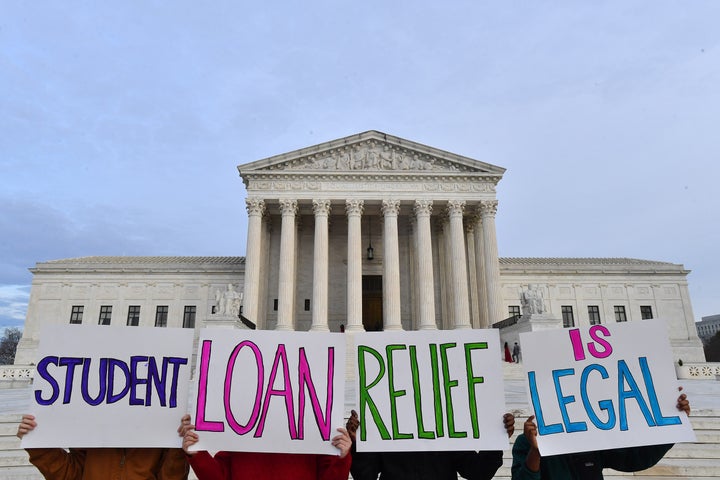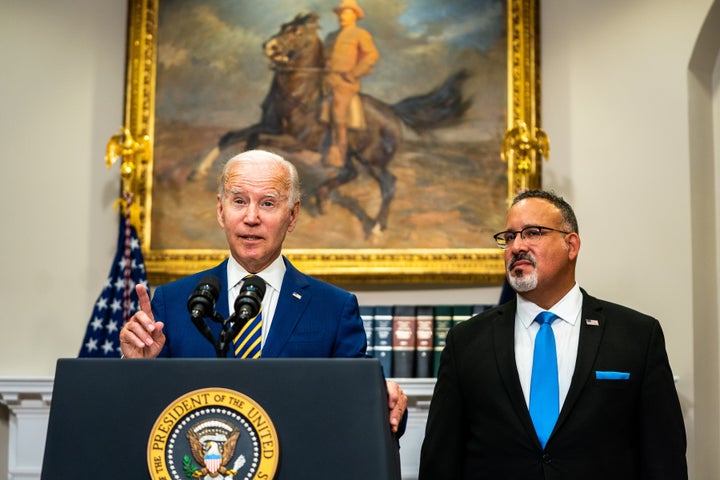The Supreme Court is slated to soon decide the financial fortunes of over 40 million Americans who are in line for significant student loan relief, when it hears arguments on the legality of President Joe Biden’s plan to provide targeted relief to student loan borrowers.
On Feb. 28, the court is expected to hear arguments about whether the millions of Americans eligible for up to $20,000 in student-loan debt forgiveness should get that relief, or whether they should be forced to continue to pay their loans.
With a six-vote conservative supermajority, it seems unlikely that the court would rule to uphold a sweeping executive-branch action by a Democratic administration that involves the redistribution of money from lenders to debtors. But there may be a way for at least some of the court’s conservatives to preserve the debt relief program while achieving a conservative goal.
The most likely way the program would survive the challenges presented in two cases — Biden v. Nebraska and Department of Education v. Brown — is if the outcome turns on the question of standing; that is, whether the parties suing to challenge the program can prove it harms them, and that they are the relevant party being harmed. If the court decides that the six states and two individuals suing the administration lack standing, the justices will not need to actually decide whether the program is legal.
“The standing theories that have been thrown at the wall in these cases are wrong, and many of them would have dangerous implications,” conservative law professors Samuel Bray and William Baude argued in a friend-of-the-court brief submitted in the case.
Despite their own belief that the administration’s debt relief plan is “unlawful,” Bray and Baude argue that none of the states or people filing suit can properly prove they would be harmed by the program. And if the court were to grant standing, it would further expand the ability of states to bring lawsuits to force or block executive actions ― something three of the conservative justices opposed in the 2007 case Massachusetts v. EPA, where the court gave the state “special solicitude” to sue to require the government to regulate carbon emissions.
Chief Justice John Roberts wrote a dissent from that decision that was joined by Justices Clarence Thomas and Samuel Alito and then-Justice Antonin Scalia. In the dissent, Roberts argued that the “special solicitude” granted to states turned standing into “a lawyer’s game, rather than a fundamental limitation ensuring that courts function as courts and not intrude on the politically accountable branches.”

The courts are meant “to decide concrete cases ― not to serve as a convenient forum for policy debates,” Roberts added.
These concerns “proved prophetic,” Bray and Baude write. Since then, there has been a dramatic increase in lawsuits filed by state attorneys general challenging federal actions while the opposing party occupies the White House. Under former President Barack Obama, GOP attorneys general led the way in filing more than 50 suits. Democratic attorneys general filed more than 130 suits when Donald Trump was president. And now Republicans have filed more than 50 such suits against Biden.
“The states’ more extravagant theories are emblematic of the broader trend where states are taking advantage of vague language in Massachusetts v. EPA, to challenge any federal action with which they disagree,” Bray and Baude write. “Unless this Court wishes to sit in constant judgment of every major executive action ― which is not its constitutional role ― it is time to say ‘stop.’”
By rejecting the standing theories offered in the student loan debt cases, Roberts and other conservatives could set forth new limits on states’ “special solicitude” for standing, or reject it entirely. This could help keep the court out of some thorny political questions while making it more difficult for liberal attorneys general to sue to enforce environmental or civil rights law. That’s something that Fordham Law School Professor Jed Shugerman, who supports student debt relief, warned about in a brief to the court in support of the state arguments for standing.
Such a move would allow Roberts to do what he has done in the past: uphold a Democratic president’s policy priority while advancing his own agenda at the same time.
The case against standing for the eight plaintiffs is fairly straightforward, according to Baude, Bray and a brief submitted by the Biden administration, among others.
Biden announced his plan to provide student-loan debt relief for some borrowers on Aug. 24, 2022. The plan provided $20,000 in relief to Pell Grant recipients and $10,000 in relief to other borrowers who made less than $125,000 a year in 2020 or 2021. Biden claimed authority under the HEROES Act of 2003 to provide debt relief during the COVID-19 national emergency.
The debt-forgiveness plan drew swift legal challenges backed by conservatives. The states of Arkansas, Iowa, Kansas, Missouri, Nebraska and South Carolina sued in the 8th Circuit, while Myra Brown and Alexander Taylor, two student borrowers, brought suit in the 5th Circuit.
Among Arkansas, Iowa, Kansas, Missouri, Nebraska and South Carolina, the 8th Circuit Court of Appeals only gave standing to Missouri. The claims of harm from the other five states were all too weak, as they were found to be either self-inflicted or nonexistent.
Iowa, Kansas, Nebraska and South Carolina claimed that they would lose tax revenue due to a 2021 law that exempts student-loan debt discharges from being calculated as “gross income.” These states allege they would lose tax revenue because they tie their own state tax definitions of “gross income” to the IRS’s definition.
However, court precedent says that a state cannot allege a harm from an act that is self-inflicted. It was the individual choice of Iowa, Kansas, Nebraska and South Carolina to tie their state tax codes to the federal tax code.
In the 1976 case of Pennsylvania v. New Jersey, the court ruled that Pennsylvania could not claim it was harmed when New Jersey enacted a new tax, despite Pennsylvania’s argument that it incurred harm because it allowed residents to claim a tax credit for taxes paid to other states. The court found that Pennsylvania did not need to provide such tax credits, and it ruled that no state “can be heard to complain about damage inflicted by its own hand.”
The claim for standing is also suspect because the alleged harm isn’t direct. In a 1927 case, after Florida challenged a federal inheritance tax on the grounds that it would cost the state tax revenue, the court rejected Florida’s argument, finding that the harm was “at most, only remote and indirect.”

The states of Arkansas, Missouri and Nebraska claim that they would lose revenue because the White House’s program only benefits direct loans over family loans, and would encourage borrowers to consolidate any family loans into direct loans. Since some state entities hold investments in family loans, these states claim they would be harmed. But the administration changed its policy to forbid debt holders from consolidating in this manner in order to receive the proposed relief.
“Borrowers with federal student loans not held by [the Department] cannot obtain one-time debt relief by consolidating those loans into Direct Loans,” the brief submitted to the court by the Biden administration notes.
As for Brown and Taylor, they both sued to challenge the plan by claiming they would not receive the promised relief in whole, for holding a private loan, or in part, for not receiving the maximum $20,000 offered to Pell Grant recipients. They argued that their ability to register their complaints was short-circuited when the administration did not post the policy through the normal notice-and-comment process.
Here, the remedy sought by Brown and Taylor, of eliminating the program entirely, does not match the harm they allege ― their exclusion from all or some of the relief. The briefs from Baude and Bray, and from the Biden administration, argue that they lack standing since eliminating the program would not resolve their alleged harms.
As for the administrative complaint, the HEROES Act exempts changes in debt payments during a declared national emergency from the normal notice-and-comment period, so the Biden administration’s brief contends that this harm does not actually exist.
That leaves Missouri ― which claims it would lose money that the state-created student loan servicer MOHELA is obligated to donate to a state capital improvements fund, because MOHELA could lose income from any loans it holds that are forgiven.
While this is the “strongest argument for standing made by any of the plaintiffs,” Bray and Baude argue, it is nevertheless problematic because “the state of Missouri is not the ‘proper party’ to bring this lawsuit.”
Despite being created by the state, MOHELA is an independent entity that has the power to sue and be sued. MOHELA, not Missouri, is the party that should be suing here, the briefs from Bray and Baude and from the Biden administration argue ― something it is conspicuously not doing.
The claim of standing because MOHELA may not be able to pay its state obligations has its own problems. Aside from the argument being speculative, the state already provides MOHELA extensions and delays in paying what it owes. It could also set a new standard for standing that would create a host of perverse consequences.
If the court were to accept such a theory, it would give “any lender” the standing to sue to block “any regulation that reduced the income of any of its borrowers,” Bray and Baude argue ― adding that “such a theory should not be taken more seriously here.”
The conservative justices may ultimately rule in favor of standing, as they have in a number of post-Massachusetts v. EPA cases where states made similar arguments. If they do, then the case would come down to whether the relief program is legal, or if it is not allowed under the court’s “major questions doctrine” that limits expansive regulatory actions that affect the economy. But standing is the best bet the Biden administration has to keep its plan intact, even if it comes with collateral damage.

